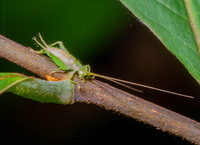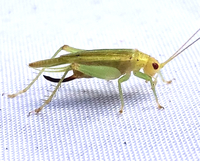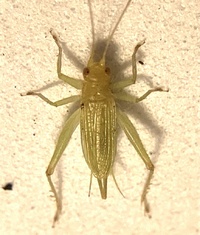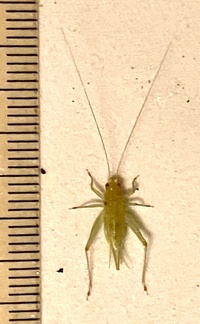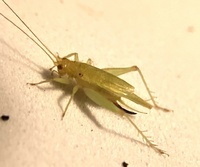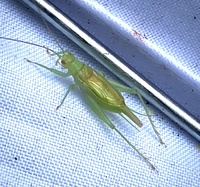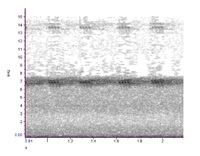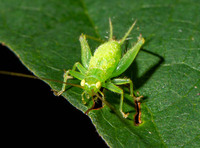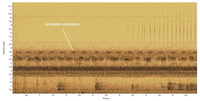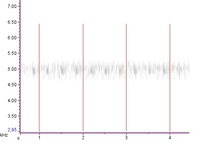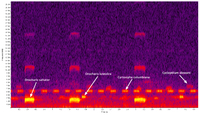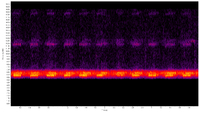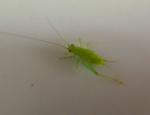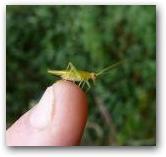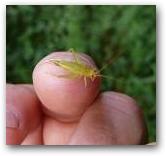Family (Alpha): ACRIDIDAE GRYLLACRIDIDAE GRYLLIDAE GRYLLOTALPIDAE RHAPHIDOPHORIDAE ROMALEIDAE TETRIGIDAE TETTIGONIIDAE TRIDACTYLIDAE
View Gryllidae Members:
Acheta domesticus Anurogryllus arboreus Gryllus unidentified species Gryllus firmus Gryllus fultoni Gryllus pennsylvanicus Gryllus pennsylvanicus/veletis Gryllus pennsylvanicus-veletis Gryllus rubens Gryllus veletis Miogryllus verticalis Velarifictorus micado Hapithus agitator Orocharis unidentified species Orocharis luteolira Orocharis saltator Cycloptilum unidentified species Cycloptilum bidens Cycloptilum pigrum Cycloptilum slossoni Cycloptilum tardum Cycloptilum trigonipalpum Cycloptilum velox Myrmecophilus pergandei Allonemobius allardi Allonemobius fultoni Allonemobius griseus griseus Allonemobius griseus funeralis Allonemobius maculatus Allonemobius socius Allonemobius sparsalsus Allonemobius tinnulus Allonemobius walkeri Allonemobius unidentified species Eunemobius carolinus Eunemobius confusus Eunemobius melodius Eunemobius unidentified species Neonemobius cubensis Neonemobius palustris Neonemobius variegatus Pictonemobius ambitiosus complex Pictonemobius ambitiosus Pictonemobius hubbelli Oecanthus unidentified species Oecanthus celerinictus Oecanthus exclamationis Oecanthus fultoni Oecanthus latipennis Oecanthus nigricornis Oecanthus niveus Oecanthus pini Oecanthus quadripunctatus Neoxabea bipunctata Phyllopalpus pulchellus Anaxipha delicatula Anaxipha exigua Anaxipha litarena Anaxipha rosamacula Anaxipha thomasi Anaxipha tinnula Anaxipha tinnulacita Anaxipha tinnulenta Anaxipha vernalis Anaxipha unidentified species Cyrtoxipha columbiana Falcicula hebardi Gryllidae unidentified species NC Records
Cyrtoxipha columbiana Caudell, 1907 - Columbian Trig
Taxonomy
Family: Gryllidae
Subfamily: TrigonidiinaeTribe: TrigonidiiniSynonym: Cyrtoxipha gundlachi columbiana Comments: One of four species in this genus that occur in North America north of Mexico (SINA, 2018), and the only one that has been recorded in North Carolina
Identification
Field Guide Descriptions: Capinera et al. (2004); Elliott and Hershberger (2007); Himmelman (2009) Online Photographs: SINA, BugGuide , Songs of Insects, Google Images ,
iNaturalist , GBIF Technical Description, Adults/Nymphs: Walker (1969)SINA 622a.htm Comments: A very small, pale yellow-green Trig. The color of the head, body, legs, and wings are pale lime green to yellow green; the eyes are often red or yellow (Caudell, 1907, said they were black). The ovipositor is contrastingly dark brown. Other Trigs are similar in size but are either brown (Anaxipha, Falcicula) or red and black (Phyllopalpus). Tree crickets are similar in color but are larger and do not have hindwings that extend beyond the tegmina.Total Length [body plus wings; excludes ovipositor]: 8.5 mm to the ends of the hindwngs, males and females (Caudell, 1907)Structural Features: The tegmina are longer than the abdomen and the curled hindwings project beyond them by half their length (Caudell, 1907). Like other Trigs, the ovipositor is sword-shaped -- sharp and curving upwards -- and is about 3.5 mm long.Singing Behavior: Songs consist of short trills -- chirps -- that have a particular clear and ringing quality. Walker (1969) described them as sounding like a "steady musical throb, reminiscent of the jing of sleigh bells in the distance." Each chirp consists of about five pulses, with a substantial break between chirps; the chirp rate is between 3-4 per second. Each syllable is over-slurred and occupying a narrow frequency range, both of which tend to give it a musical quality. The dominant frequency at 80 F (26 C) is between 6.6 and 7 kHz (SINA, 2018). As first noted by Allard (1910): "These crickets sometimes congregate in great numbers in certain trees. Their trills then become wonderfully synchronal until veritable waves of music issue from the trees." According to Fulton (1932), this is one of only three species in North Carolina known to have synchronal singing, the others being Oecanthus fultoni and Neoconocephalus exiliscanorus (True Katydids also synchronize their songs within small groups but alternate their songs with other groups; in Cyrtoxipha, all males in a chorus may be synchronized).Recording playback at normal speed.
Download Video:
"MP4"
Nymphal Stages and Development: Apparently undescribed
Distribution in North Carolina
County Map: Clicking on a county returns the records for the species in that county.
Adult Dates: Click on graph to enlarge
Habitats and Life History
Habitats: This species inhabits small to large deciduous trees and shrubs, with habitats including peach orchards as well as mature hardwood forests. Elliott and Hershberger (2007) noted a preference -- at least in developed areas -- for Bradford Pears and Crape Myrtles. One large chorus recorded in west Raleigh was, in fact, associated with these species. Diet: Apparently undescribed but probably omnivorousObservation Methods: Mostly easily detected by its song, which is usually performed up in the trees out of reach. Elliott and Hershberger (2007) state that they can be collected by shaking the trees where they are present, knocking them down onto a sheet spread underneath. They also can be found on cars parked beneath their choruses, especially following a rain.Abundance/Frequency: Males typically sing in choruses, which can be very largeAdult Phenology: In the vicinity of Raleigh, Fulton (1951) observed that males start singing in mid-July and persist until early October. We now have records from west Raleigh as early as late June and at least one from as late as October 22.
Status in North Carolina
Natural Heritage Program Status: Natural Heritage Program Ranks: [GNR] [S5?]State Protection: Has no legal protection, although permits are required to collect it on state parks and other public landsComments: Although we still have too few records for this species in North Carolina -- probably reflecting the difficulty in collecting specimens -- they do not appear to be specialized in terms of habitats or host plants and probably occur commonly across most of the state. Provisionally, at least, they appear to be quite secure in the state.
Image Gallery for Cyrtoxipha columbiana - Columbian Trig Recorded by: Ken Kneidel Recorded by: Ken Kneidel Recorded by: Ken Kneidel Recorded by: David George Recorded by: Ken Kneidel Recorded by: Ken Kneidel Recorded by: Ken Kneidel Recorded by: Ken Kneidel Recorded by: Steve Hall and Bo Sullivan Recorded by: Steve Hall and Dee Stuckey Recorded by: Steve Hall and Dee Stuckey Recorded by: Steve Hall and Bo Sullivan Recorded by: Ken Kneidel Recorded by: Ken Kneidel Recorded by: Jim Petranka and Becky Elkin Recorded by: Steve Taylor Recorded by: Steve Taylor Recorded by: Steve Hall Recorded by: Steve Hall Recorded by: Steve Hall Recorded by: j.wyche Recorded by: F. Williams,J. Wyche Recorded by: Ken Kneidel Recorded by: FKW Recorded by: FKW
MP3 Gallery for Cyrtoxipha columbiana - Columbian Trig 1
Your browser does not support the audio element.
Recorded by: Ken Kneidel 2
Your browser does not support the audio element.
Recorded by: Ken Kneidel 3
Your browser does not support the audio element.
Recorded by: Jim Petranka and Becky Elkin
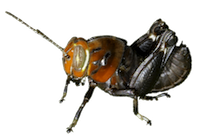
 »
»